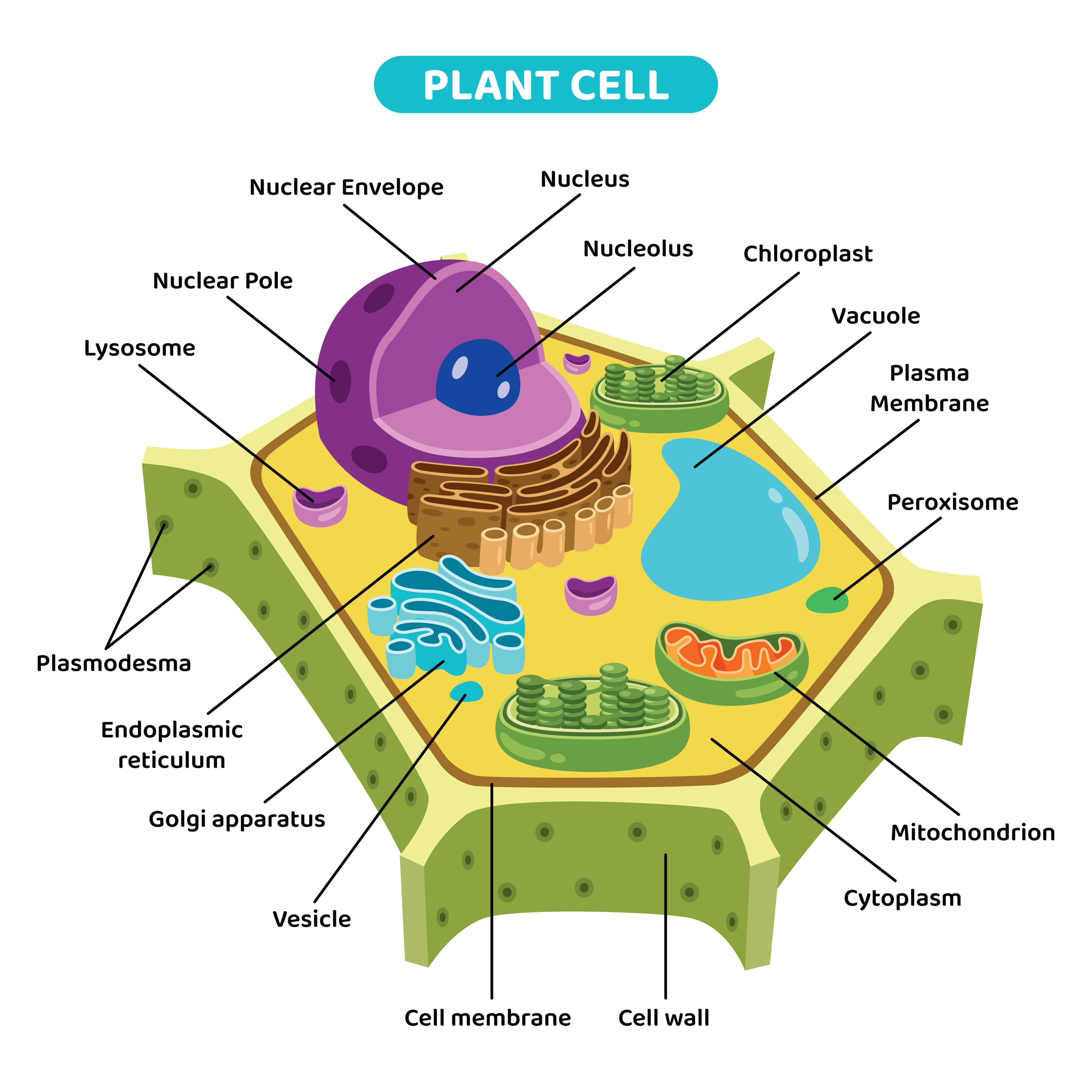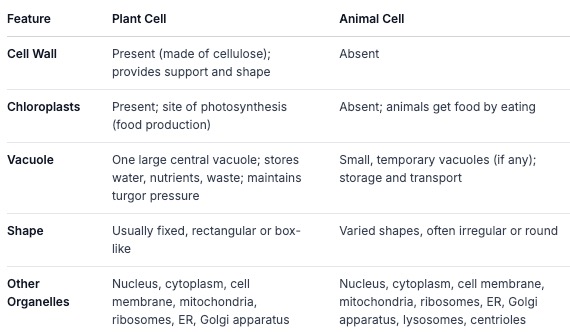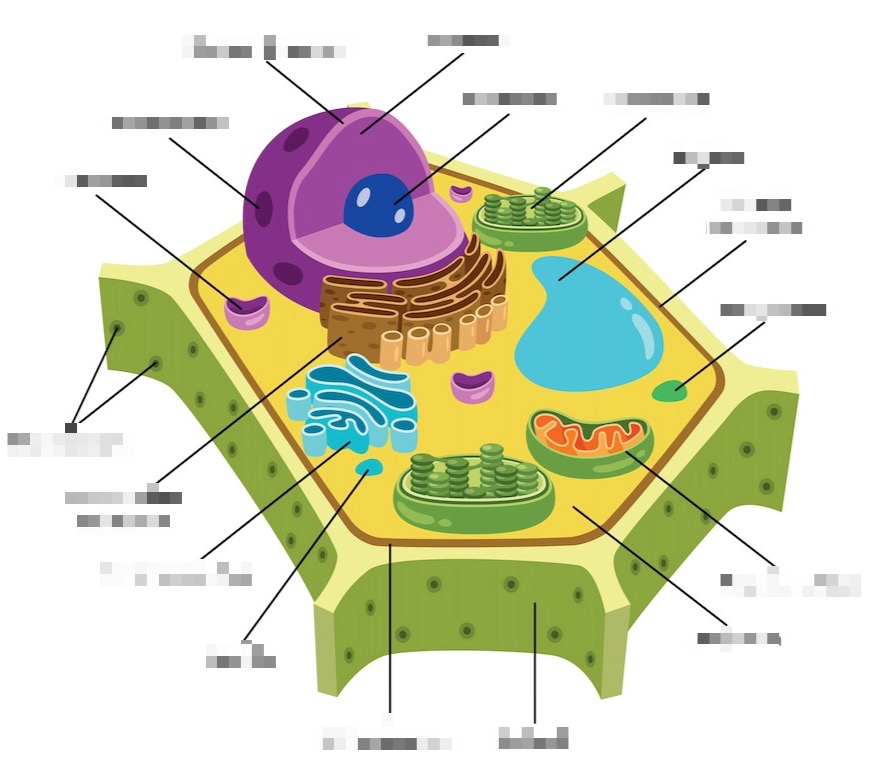A Closer Look at Cells: Plant vs. Animal
A Closer Look at Cells: Plant vs. Animal
At the end of this lesson, you are expected to:
Identify the cell wall, chloroplasts, and large central vacuole in plant cells.
Explain the functions of the cell wall, chloroplasts, and large central vacuole.
Differentiate plant cells from animal cells based on these unique organelles.
Warm-Up Activity: "Cell Detective"
Imagine you are a detective, and your mission is to find clues that tell you if a cell is a plant cell or an animal cell. You have two mystery boxes, labeled "Mystery Box A" and "Mystery Box B." Inside each box are pictures of cells. Your job is to look closely at the pictures and decide which box contains plant cells and which contains animal cells. What clues would you look for? Think about the shapes, the outer layers, and any special parts you might see. Jot down your initial ideas about what makes a plant cell different from an animal cell.
Lesson Proper:
Welcome, young scientists, to an exciting journey into the world of cells! You've already learned that cells are the basic building blocks of all living things. Today, we're going to become "Cell Detectives" and uncover the amazing secrets of plant cells. We'll focus on three special "superstar" organelles that make plant cells unique and powerful: the cell wall, chloroplasts, and the large central vacuole. We'll also see how these differ from the cells that make up animals, like you and me!
What is a Cell? A Quick Recap!
Before we dive into the plant cell superstars, let's quickly remember what a cell is. Think of a cell as a tiny, busy factory. Each factory has different rooms, called organelles, that do specific jobs to keep the factory running. All living things, from the smallest ant to the tallest tree, are made of these tiny factories. Some living things, like bacteria, are made of just one cell (they are unicellular), while others, like plants and animals, are made of many, many cells working together (they are multicellular).

The Mighty Plant Cell: Our Focus Today!
Plants are incredible! They can make their own food using sunlight, they stand tall and strong, and they store water and nutrients. These abilities come from their special cell structures. Let's meet our plant cell superstars!
Superstar 1: The Cell Wall – The Plant's Sturdy Armor!
Imagine a knight wearing a strong suit of armor. This armor protects the knight and helps him stand up straight. Plant cells have something similar – it's called the cell wall.
What it is: The cell wall is a tough, rigid outer layer that surrounds the cell membrane of plant cells. It's like a protective shield or a strong box around the cell. It's made mostly of a tough material called cellulose, which is also found in paper and cotton!
What it does:
Protection: The cell wall protects the plant cell from harm, like a shield protecting a knight. It keeps the cell safe from injury and from harmful things that might be outside.
Support and Shape: Because it's rigid, the cell wall gives the plant cell a definite, strong shape, usually rectangular or box-like. This is why plants can stand tall and don't just flop over! Think about a celery stalk – it's crisp and firm because of the strong cell walls in its cells.
Prevents Over-swelling: When a plant cell takes in a lot of water, the inside of the cell (the cytoplasm) pushes against the cell membrane. If there were no cell wall, the cell membrane would stretch and might even burst! The strong cell wall prevents this from happening, acting like a strong container that can only stretch so much. This pushing of the cell contents against the cell wall is called turgor pressure, and it's super important for keeping plants firm and upright.
Real-World Example: Think about a crunchy carrot or a crisp lettuce leaf. The crispness and firmness you feel are due to the turgor pressure created by water pushing against the strong cell walls within the plant cells. If a plant doesn't get enough water, the cells lose turgor pressure, and the plant wilts.
Comparison with Animal Cells: Do animal cells have cell walls? Nope! Animal cells only have a cell membrane as their outer boundary. This is one of the main reasons why animal cells can have many different shapes (like nerve cells or muscle cells) and why animals don't have rigid structures like plants. We can move and bend because our cells are more flexible.
Superstar 2: Chloroplasts – The Plant's Tiny Food Factories!
This is perhaps the most amazing superstar! Plants are unique because they can make their own food. How do they do it? With the help of chloroplasts!
What it is: Chloroplasts are special organelles found inside plant cells (and some algae). They are usually green because they contain a pigment called chlorophyll. This is the same pigment that makes leaves green!
What it does: Chloroplasts are the sites of photosynthesis. Photosynthesis is the process where plants use sunlight, water, and carbon dioxide from the air to create their own food (sugar, called glucose) and release oxygen. It's like a tiny solar-powered kitchen inside the cell!
The process looks like this: Sunlight + Water + Carbon Dioxide → Sugar (Food) + Oxygen
Chlorophyll in the chloroplasts captures the energy from sunlight, which is then used to convert water and carbon dioxide into sugar. This sugar provides energy for the plant to grow, reproduce, and carry out all its life functions. The oxygen released is what we and other animals breathe!
Real-World Example: When you eat a piece of fruit or a vegetable, you are eating the food that the plant made using photosynthesis in its chloroplasts. The energy you get from eating that apple or spinach originally came from the sun, captured by the chloroplasts in the plant's cells!
Comparison with Animal Cells: Do animal cells have chloroplasts? No! Animals cannot make their own food. We have to eat other plants or animals to get the energy we need. That's why we have mouths and digestive systems – to take in food from the outside.
Superstar 3: The Large Central Vacuole – The Plant's Water Tank and Storage Unit!
Imagine a big storage room or a water tank inside the cell. That's what the large central vacuole is like in a plant cell.
What it is: The large central vacuole is a huge, membrane-bound sac that can take up a large portion of the plant cell's volume – sometimes up to 90%! It's filled with a watery solution called cell sap.
What it does:
Storage: The vacuole stores water, nutrients, ions, pigments (like the ones that give flowers their colors), and waste products. It's like the cell's pantry and recycling center.
Maintains Turgor Pressure: As we mentioned earlier, the vacuole plays a crucial role in maintaining turgor pressure. When the vacuole is full of water, it pushes against the cell wall, keeping the cell firm and supporting the plant. This is vital for keeping leaves and stems from wilting.
Waste Disposal: It can also store waste products, preventing them from harming the rest of the cell.
Real-World Example: Have you ever seen a flower wilt when it hasn't been watered for a while? The petals and leaves droop because the large central vacuoles in the plant cells have lost water. When you water the plant, the vacuoles fill up again, and the plant perks up! Also, the vibrant colors of many flowers are due to pigments stored in the vacuoles.
Comparison with Animal Cells: Animal cells might have small vacuoles, but they are usually temporary and used for storing or transporting substances. They do not have one large, central vacuole like plant cells do. This difference is key to understanding why plants can maintain their rigid structure and store large amounts of water.
Putting It All Together: Plant vs. Animal Cells
Let's summarize the key differences we've discovered today:
 A Story to Remember:
A Story to Remember:
Once upon a time, in the land of "Cell-a-bration," lived a proud Plant Cell named Petunia. Petunia was very strong and stood tall thanks to her sturdy cell wall, her protective armor. Inside her, she had tiny green kitchens called chloroplasts, where she busily made her own sugary food using sunlight. She also had a giant water balloon, her large central vacuole, which kept her full and firm and stored all sorts of goodies.
Nearby lived Annie the Animal Cell. Annie was more flexible and could change her shape. She didn't have a cell wall, so she was a bit squishier. Annie also didn't have chloroplasts, so she had to go out and find food. She had small storage bags (vacuoles) but nothing as grand as Petunia's.
One sunny day, a strong wind blew. Petunia, with her strong cell wall and full vacuole, stood firm. Annie, however, wobbled a bit. Later, when the sun shone brightly, Petunia used her chloroplasts to make food, feeling energized. Annie had to wait until lunchtime to eat her sandwich. Petunia and Annie were different, but both were essential parts of the living world!
Elaborate on Key Concepts:
Cellulose: This is a complex carbohydrate that forms the main structural component of the cell wall in plants. It's a long chain of sugar molecules linked together. Cellulose is indigestible for most animals, but it's important for fiber in our diet.
Photosynthesis: This is a vital process for life on Earth. It converts light energy into chemical energy stored in glucose. The equation is a simplified way to understand it: 6CO₂ (Carbon Dioxide) + 6H₂O (Water) + Light Energy → C₆H₁₂O₆ (Glucose) + 6O₂ (Oxygen). Chlorophyll is the key molecule that absorbs light energy.
Turgor Pressure: This is the pressure exerted by the cell contents against the cell wall. It's essential for maintaining the rigidity and shape of plant tissues. When a plant wilts, it means the turgor pressure has decreased because the cells have lost water.
Enrichment Activities:
Guided Practice: "Label the Plant Cell"
Here is a diagram of a plant cell. Your teacher (or you, if you're working alone!) will point to different parts. See if you can identify them and say what they do. Pay special attention to the cell wall, chloroplasts, and the large central vacuole!

Interactive Activity: "Cell Sorting Game"
Imagine you have cards with pictures of different cell parts and their functions. You also have cards with pictures of plant cells and animal cells. Your task is to match the cell parts to the correct cell type (plant or animal) and match the functions to the correct organelles. You can even draw your own plant and animal cells and label them with the correct organelles!
Independent Practice: "Compare and Contrast Table"
Create a table like the one we used in the lesson proper. Fill it in with the key features of plant and animal cells. Then, write a short paragraph explaining the three main differences you learned about today (cell wall, chloroplasts, and large central vacuole) and why these differences are important for plants.
Real-World Connection:
Think about the food you eat every day. Fruits, vegetables, grains – all come from plants. The energy in these foods was originally captured from sunlight by the chloroplasts in plant cells. The structure of plants, from the strong trunk of a tree to the crispness of a salad, is supported by the cell walls and turgor pressure maintained by the large central vacuoles. Understanding plant cells helps us appreciate where our food comes from and how plants function to support life on Earth. It also helps us understand why plants need water and sunlight to survive.
What I Have Learned:
Today, I learned that plant cells have special features that make them unique. The cell wall gives them strength and shape. Chloroplasts are like tiny solar-powered kitchens that make food through photosynthesis. The large central vacuole acts as a storage tank and helps keep the plant firm. These organelles are not found in animal cells, which is why plants and animals live and function so differently.
What I Can Do:
I can now look at a picture of a cell and try to identify if it's a plant cell or an animal cell based on the presence of a cell wall, chloroplasts, and a large central vacuole.
I can explain to my family or friends why plants need sunlight and water to stay healthy, relating it to chloroplasts and vacuoles.
I can appreciate the role of plants in providing food and oxygen for all living things, thanks to photosynthesis.
I can draw and label a plant cell, highlighting its unique organelles.
No Comments Yet